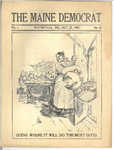Keywords: Lake George
- Historical Items (82)
- Tax Records (0)
- Architecture & Landscape (2)
- Online Exhibits (36)
- Site Pages (23)
- My Maine Stories (3)
- Lesson Plans (0)
Online Exhibits
Your results include these online exhibits. You also can view all of the site's exhibits, view a timeline of selected events in Maine History, and learn how to create your own exhibit. See featured exhibits or create your own exhibit
Exhibit
Visitors to the Maine woods in the early twentieth century often recorded their adventures in private diaries or journals and in photographs. Their remembrances of canoeing, camping, hunting and fishing helped equate Maine with wilderness.
Exhibit
John Dunn, 19th Century Sportsman
John Warner Grigg Dunn was an accomplished amateur photographer, hunter, fisherman and lover of nature. On his trips to Ragged Lake and environs, he became an early innovator among amateur wildlife photographers. His photography left us with a unique record of the Moosehead Lake region in the late nineteenth century.
Exhibit
Good Will-Hinckley: Building a Landscape
The landscape at the Good Will-Hinckley campus in Fairfield was designed to help educate and influence the orphans and other needy children at the school and home.
Exhibit
Maine's ample woods historically provided numerous game animals and birds for hunters seeking food, fur, or hides. The promotion of hunting as tourism and concerns about conservation toward the end of the nineteenth century changed the nature of hunting in Maine.
Exhibit
Princeton: Woods and Water Built This Town
Princeton benefited from its location on a river -- the St. Croix -- that was useful for transportation of people and lumber and for powering mills as well as on its proximity to forests.
Exhibit
Mainers have been held prisoners in conflicts fought on Maine and American soil and in those fought overseas. In addition, enemy prisoners from several wars have been brought to Maine soil for the duration of the war.
Exhibit
In Time and Eternity: Shakers in the Industrial Age
"In Time and Eternity: Maine Shakers in the Industrial Age 1872-1918" is a series of images that depict in detail the Shakers in Maine during a little explored time period of expansion and change.
Exhibit
We Used to be "Normal": A History of F.S.N.S.
Farmington's Normal School -- a teacher-training facility -- opened in 1863 and, over the decades, offered academic programs that included such unique features as domestic and child-care training, and extra-curricular activities from athletics to music and theater.
Exhibit
Music in Maine - Community Music
"… Songs of Labor Luther Hall's Camp - Grand Lake Narrows Sebois, 1920Patten Lumbermen's Museum From agriculture to industry, work and…"
Exhibit
At the heyday of trolleys in Maine, many of the trolley companies developed recreational facilities along or at the end of trolley lines as one further way to encourage ridership. The parks often had walking paths, dance pavilions, and various other entertainments. Cutting-edge technology came together with a thirst for adventure and forever changed social dynamics in the process.
Exhibit
For one hundred years, Acadia National Park has captured the American imagination and stood as the most recognizable symbol of Maine’s important natural history and identity. This exhibit highlights Maine Memory content relating to Acadia and Mount Desert Island.
Exhibit
Rum, Riot, and Reform - Quenching the Thirst
"… 378 B674Q-b Athian Lewey, West Grand Lake, 1898Maine Historical Society Atbian Lewey at Grand Lake, Maine Jim M'Kin, 1898 Photograph…"
Exhibit
Rum, Riot, and Reform - Politics and Enforcement
"X Maine State Temperance Camp-Meeting Sebago Lake, 1876 Collections of Maine Historical Society Coll."
Exhibit
"… life and music Established in 1783, Sabbathday Lake Shaker Village in New Gloucester is, as of 2024, home to the only active Shaker Community in…"
Exhibit
Music in Maine - Music Education
"… an organization that purchased 190 acres on Lake Messalonskee in Sidney for a summer music camp."
Exhibit
Maine has some 17 million acres of forest land. But even on a smaller, more local scale, trees have been an important part of the landscape. In many communities, tree-lined commercial and residential streets are a dominant feature of photographs of the communities.
Exhibit
The boundaries of Maine are the product of international conflict, economic competition, political fights, and contested development. The boundaries are expressions of human values; people determined the shape of Maine.
Exhibit
<i>Of Note: Maine Sheet Music</i> features captivating covers of original sheet music along with stories about Maine connections to the songs. Before people had easy access to popular music from records, radios, and the internet, they played songs of the day on instruments at home, using sheet music purchased at music stores. Iconic Maine subjects like lobsters, pine trees, and winter were perfect for lyrics sung by luminaries like Rudy Vallée of Westbrook, and intricate artwork of Maine's landscape graced the sheet music covers.
Exhibit
Washington County Through Eastern's Eye
Images taken by itinerant photographers for Eastern Illustrating and Publishing Company, a real photo postcard company, provide a unique look at industry, commerce, recreation, tourism, and the communities of Washington County in the early decades of the twentieth century.
Exhibit
Paper has shaped Maine's economy, molded individual and community identities, and impacted the environment throughout Maine. When Hugh Chisholm opened the Otis Falls Pulp Company in Jay in 1888, the mill was one of the most modern paper-making facilities in the country, and was connected to national and global markets. For the next century, Maine was an international leader in the manufacture of pulp and paper.
Exhibit
Colonial Cartography: The Plymouth Company Maps
The Plymouth Company (1749-1816) managed one of the very early land grants in Maine along the Kennebec River. The maps from the Plymouth Company's collection of records constitute some of the earliest cartographic works of colonial America.
Exhibit
Summer Folk: The Postcard View
Vacationers, "rusticators," or tourists began flooding into Maine in the last quarter of the 19th century. Many arrived by train or steamer. Eventually, automobiles expanded and changed the tourist trade, and some vacationers bought their own "cottages."
Exhibit
Margaret Chase Smith: A Historic Candidacy
When she announced her candidacy for President in January 1964, three-term Republican Senator Margaret Chase Smith became the first woman to seek the nomination of one of the two major political parties.
Exhibit
Maine Eats: the food revolution starts here
From Maine's iconic lobsters, blueberries, potatoes, apples, and maple syrup, to local favorites like poutine, baked beans, red hot dogs, Italian sandwiches, and Whoopie Pies, Maine's identity and economy are inextricably linked to food. Sourcing food, preparing food, and eating food are all part of the heartbeat of Maine's culture and economy. Now, a food revolution is taking us back to our roots in Maine: to the traditional sources, preparation, and pleasures of eating food that have sustained Mainers for millennia.
























